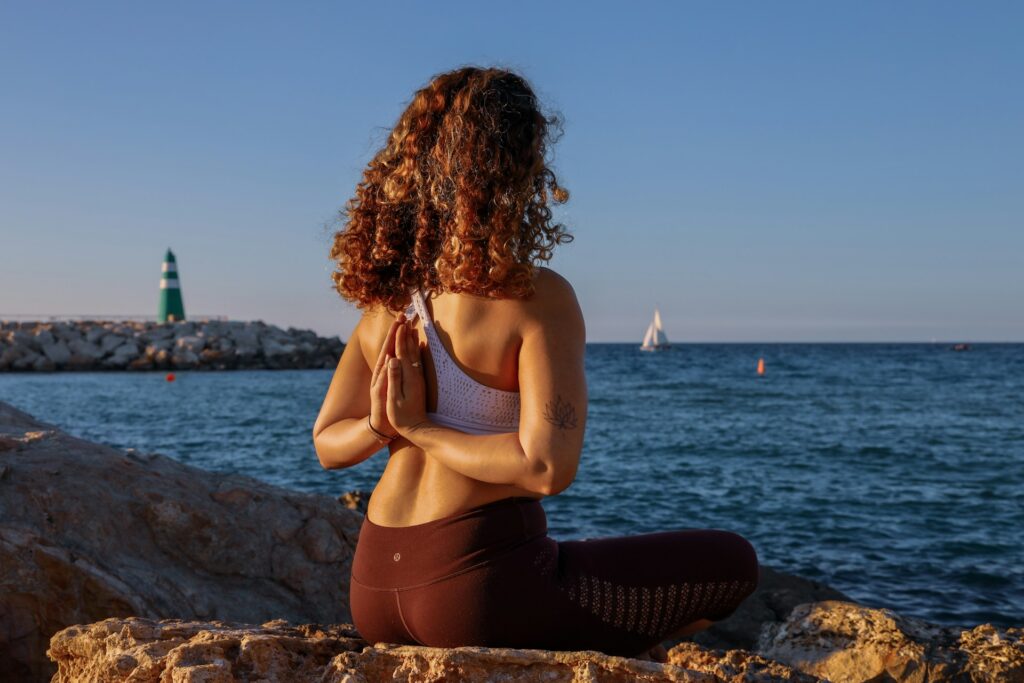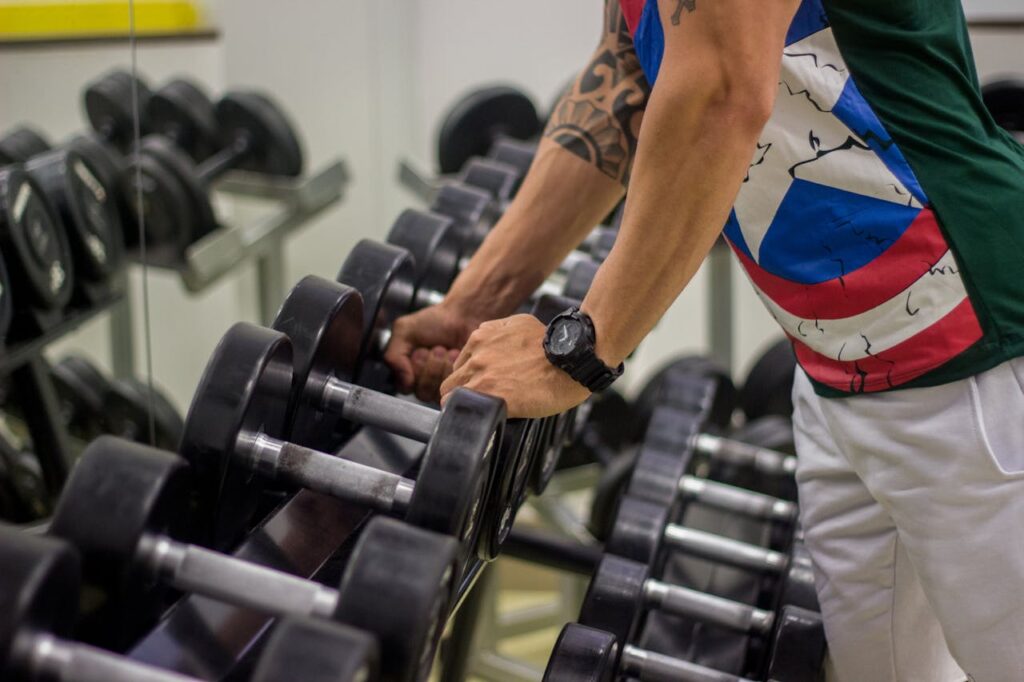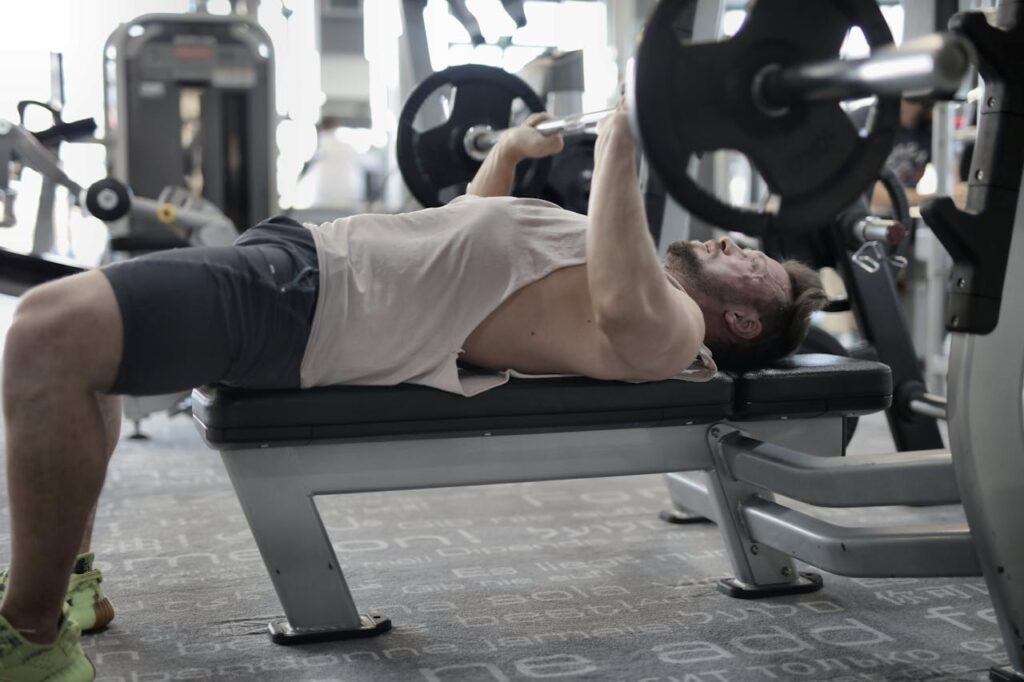Can You Workout After Getting a Tattoo?
Table of Contents

Photo credit: Alora Griffiths via Unsplash
You shouldn’t work out immediately after getting a tattoo, because your skin needs time to heal. That’s the short answer. The long answer is more complex and determined by factors like the type of exercise you want to do, where your tattoo is located and how soon you want to work out.
So if not immediately, when can you work out after getting a tattoo?
I get it. It sucks having to interrupt your workout routine and potentially disrupt all that momentum you’ve had going for you. But believe me, patience is key right now. Your tattoo artist would agree. Because if you work out too soon after getting a new tattoo, you could really mess with the healing process.
You need to take it easy and be cautious. If you do it right, you’ll be working out in no time and showing off a beautiful and healthy tattoo. Do it wrong and you could be dealing with some horrendous aftercare outcomes.
When Can You Work Out After Getting a Tattoo?
Look, I know you’re eager to get your sweat on. But generally speaking, you’re going to have to wait at least 48 hours before doing anything. And I mean anything. Even light exercise is risky for your tattoo at this point. You need to take the time to rest and let your skin heal.
For some people, they can do some light activity after two or three days. But it really depends on your new tattoo, skin and where the tattoo is located. A 2023 study showed that it generally takes wounds 4-6 weeks for full healing.
This is the timeframe you should be aiming for before working out again. However, you may be able to throw in a little exercise here and there. Here’s a general timeline, but it’s not set in stone. You’ll need to treat your tattoo as its own unique case. I also recommend playing it safe.
After 2-3 Days
In most situations, you should be able to do a little light exercise at this point. I’m talking about walking or some very gentle stretching. You shouldn’t do anything strenuous or that causes you to sweat.
After 1-2 Weeks
After one or two weeks, you can get some moderate-intensity workouts in. You still don’t want to be expanding and contracting the tattooed area, causing any friction around it. Also avoid sweating too much or any exercise that involves being submerged in water (e.g. swimming).
After 4 Weeks
Typically, you’ll be able to resume your regular workout routine now. However, you still need to check your tattoo is okay and not showing any signs of irritation or complications. Check with your tattoo artist about the tattoo placement and what you’re planning on doing.

Photo credit: Lisa Marie Theck via Unsplash
Which Body Areas Need More Time Before Working Out?
After you get a new tattoo, some parts of your body might make it a bit tricky to exercise. Things like movement, friction, and sweat can really affect proper healing. So, it’s a good idea to keep these factors in mind to help your tattoo heal properly and stay looking tip top.
If you’ve just gotten ink in one of the following areas, you might need to wait longer than four weeks before exercising or doing certain exercises.
Elbows and Knees
Getting a tattoo over these joints can be tricky since they bend and stretch a lot. This constant movement can slow down the healing process and might even mess with the design.
Wrists and Ankles
These areas are always getting involved in a variety of exercise movements. They cop a lot of friction as well, so you may need to stick to leg or arm workouts, depending on where you’ve gotten your tattoo.
Feet
Tattoos on your feet take a beating from all the standing and walking. Plus, wearing training shoes can create friction and trap moisture, which can slow down healing. It’s best to steer clear of closed-toe shoes and limit walking or running during the early healing stages.
Hands and Fingers
Your hands and fingers are always busy and exposed to all sorts of things, which means they move a lot and can get contaminated easily. Tattoos here take a longer time to heal, generally, so you may need to wait longer before working out.
Ribs and Abdomen
If you’re doing exercises that stretch or contract your torso, like ab workouts or certain yoga poses, it can put a strain on tattoos in these areas. It’s best to play it safe here and avoid most exercises as your core plays a part in almost every movement.
Shoulders and Upper Back
When you’re moving your shoulders or carrying heavy stuff, the friction from clothing or straps can irritate a new shoulder tattoo. Some lower-body exercises might be alright if you only use your bodyweight.
What Can Happen if You Work Out Too Soon?
You need to remember that you’ve essentially got a flesh wound somewhere on your body. This wound needs to heal properly or else you can encounter complications during the healing process. If you don’t follow proper tattoo aftercare, these can include:
1. Getting an Infection
The more your tattoo wound is open and exposed to the elements, the higher you risk getting an infection. When you exercise, you might be continuously opening that wound. Your sweat and heat can also create an environment prone to bacteria growth.
If your tattoo gets infected, it could be permanently damaged or scarred. Infections can also cause physical illness. Read our article on why your tattoo might be itchy for more information.
2. Slowing Down Your Healing
Like any flesh wound, a new tattoo takes time to heal. In order to heal, your tattoo will form a scab, allowing new skin cells to eventually close over the wound.
The thing is, if you’re constantly stretching your skin through excessive movement, especially bending, the scab can break and the new skin cells can take longer to form. This will delay the healing process, which can increase your risk of infection, itchiness and permanent scarring. Speaking of…
3. Risking Long-Term Scarring
If you’re constantly reopening or aggravating your healing tattoo, you might cause permanent scarring. This could change your new tattoo’s appearance. So you end up with something on your body you no longer like or want to look at.
4. Damaging the Tattoo
Either through scarring or excessive expanding and contracting, you can cause permanent damage to your tattoo. Woking out typically requires a lot of movements that stretch your skin. If your ink is still settling and healing, this movement can distort the image.
5. Increasing Irritation of the Area
If you don’t allow your new tattoo to heal well, you could experience more irritation around the area. This could range from redness and swelling to itchiness and pain. Check with your tattoo artist if the irritation seems unusual.

Photo credit: Mor Shani via Unsplash
Which Exercises Are Safest After Getting a New Tattoo?
If you’re looking to stay active while your new tattoo is healing, there are some low-intensity exercises you can do. In most cases, these won’t cause any risk to your tattoo. However, as always, stop if you feel they’re causing harm.
1. Walking
A nice, easy stroll is a fantastic way to keep moving without overdoing it. Just protect the tattooed area from any rubbing against tight clothing or accessories.
2. Light Stretching
Gentle stretching can help keep your muscles flexible. Just steer clear of any stretches that might pull on or around the tattooed skin to avoid irritation. For instance, if you have just gotten a thigh tattoo, avoid leg stretches.
3. Restorative Yoga
This type of yoga is all about gentle movements and poses that encourage relaxation and flexibility. Choose positions that don’t put pressure on or stretch the tattooed skin.
4. Seated Upper Body Exercises
If your tattoo is on your lower body, try some seated exercises for your arms and shoulders, like bicep curls or shoulder presses with light weights. Just make sure these movements don’t involve the tattooed area.
5. Core Exercises
For tattoos on your limbs, you can do some gentle core exercises, like seated abdominal contractions, as long as they don’t require too much movement of the tattooed area.
Which Exercises Are Riskiest After Getting a Tattoo?
Some exercises can really mess with the healing process and even change how your new ink looks. Here’s a rundown of workouts to be careful with:
1. High-Intensity Interval Training (HIIT)
HIIT is all about quick, intense movements that can make you sweat a lot and stretch your skin. This can raise the chances of infection and messing with your healing skin.
2. Weightlifting
Be cautious with heavy lifting, especially if it involves muscles close to your tattoo. For example, doing bench presses after getting a chest tattoo can put too much pressure on that sensitive area. Another one: doing squats after getting a leg tattoo is a big no-no.
3. Running and Cycling
These cardio workouts can create repetitive motion and friction, which can be a real hassle for tattoos on your legs, thighs, or feet. Constant movement might irritate the area and slow down healing. Sweating too much can also mess with your tattoo.
4. Hot Yoga
The heat and sweat in hot yoga can bring bacteria to your fresh tattoo, increasing the risk of infection. Some yoga is okay, but definitely not any intense, sweaty yoga.
5. Swimming
Diving into water, whether it’s a pool, lake or ocean, can expose your new tattoo to bacteria and chemicals like chlorine. This can lead to infections and might even cause your ink to fade faster.
6. Contact Sports
Any sport that involves physical contact can be risky. It can lead to injury, introduce bacteria, and slow down the healing process. Best to avoid these for as long as possible.
How Do You Keep Your Tattoo Safe While Exercising?
Eventually, you’re going to want to exercise. There’s no way around it. When you feel you’re ready to work out after getting your tattoo, follow these tips to keep your tattoo safe.
- Keep It Clean and Dry – When you sweat, bacteria can sneak in and cause infections. So, after your workout, make sure to gently wash the area with a mild, fragrance-free soap and then pat it dry.
- Wear Loose Fitting Clothing – To avoid any irritation, go for loose-fitting clothes that won’t rub against your tattoo. Fabrics that breathe will help keep the area dry and comfy.
- Stay Out of Direct Sunlight and Water – It’s best to avoid sun exposure and swimming until it’s completely healed. UV rays and water can really slow down the healing process.
- Watch for Complications – Keep an eye out for any signs of infection, like excessive redness, swelling, or unusual discharge. If you notice any of these, don’t hesitate to reach out to a healthcare professional.
- Wipe Down Gym Equipment – If you’re hitting the gym, remember to wipe down the equipment before and after you use it to help stop the spread of bacteria.
- Clean and Moisturize – After your workout, gently clean your tattoo with mild soap and water, then apply a fragrance-free moisturizer to keep your skin hydrated.

Photo credit: Wand Fotografia via Pexels
Can Sweat Really Damage a Tattoo?
Getting a new tattoo is like having an open wound. If you’re not careful with how you manage sweat, it can lead to a bunch of issues while your tattoo heals.
1. Increased Infection Risk From More Bacteria
Since sweat isn’t sterile and contains things like salts and urea, it can pool on an open wound and become home for bacteria. This ups your chances of getting a skin infection, which isn’t just bad for your health but can also mess with how your tattoo looks.
2. Disrupted Healing
When you get a tattoo, your skin produces plasma and other fluids that help keep the fresh ink in place. If you sweat too much, it can wash away these essential fluids, which might interfere with the ink setting. This could fade your tattoo or make it look blurry, permanently.
3. Increased Irritation
Sweat can mix with your healing skin, causing extra irritation, inflammation and redness. Plus, if your clothes or gym equipment rub against your skin while it’s sweaty, it can lead to more scabbing or even cause scabs to come off too soon. This might disturb the tattoo and result in uneven healing or patchy ink.
Can Lifting Weights Really Stretch Your Tattoo?
Lifting won’t permanently ‘stretch’ your tattoo in the literal sense. Unless you’re building muscle incredibly quickly in that area. However, there are ways it can give the appearance that your tattoo has stretched. Or it can temporarily or permanently change your tattoo’s appearance, which is stressful enough.
When you lift heavy weights, like bench presses, squats, or deadlifts, the skin over your muscles can stretch. If you’ve got a healing tattoo in that area, the stretching can make the tattoo appear a bit distorted or stretched out. It usually goes back to normal once your skin relaxes. However, if you keep overloading or stretching that tattooed area, some designs might end up looking blurred or uneven.
When it comes to a new tattoo, the healing phase is super important. Too much movement can mess with the healing process. This can lead to ink loss or uneven healing, which might make it seem like the tattoo has been stretched. Once your tattoo is fully healed, your skin becomes more resilient and can handle regular muscle contractions without any lasting changes to your tattoo.
Tattoos in areas where the skin stretches a lot during workouts (e.g. biceps, chest and forearms) are more prone to showing signs of stretching. So you might want to mix up your workout routine while your tattoo heals in a certain area. But as always, the safest option is to just wait until your tattoo has healed before going to the gym.

Photo credit: Andrea Piacquadio via Pexels
Is Working Out Safer If You’re Using a Bandage Like Second Skin?
It’s usually a good idea to work out with a fresh tattoo covered by a bandage like Second Skin rather than leaving it exposed. This bandage helps shield your tattoo from germs, friction, and other irritants in the environment.
Second Skin and similar medical-grade adhesive bandages create a protective layer over your tattoo. This keeps it safe from gym equipment and airborne bacteria and can reduce friction and irritation from clothing or exercise surfaces. Using a bandage can also help maintain a moist environment that speeds up proper healing.
That said, there are a few things to keep in mind when using a bandage while working out:
1. Sweat Buildup
When you exercise, sweating is inevitable. Although Second Skin is designed to let your skin breathe, sweat can build up under the bandage. This could welcome bacteria if you don’t handle it well. So if you are working out with a bandage, make sure you:
- Remove the bandage right after your workout
- Gently wash the tattoo with a mild, unscented cleanser
- If necessary, put on a fresh bandage
2. Workout Duration and Intensity
While the bandage provides some protection, you should still avoid high-intensity or long workouts. Your tattoo is still healing and vulnerable, so even with a barrier, it’s best to avoid heavy sweating or straining the area too much.
Final Thoughts on Working Out After Getting a Tattoo
No one’s saying you shouldn’t work out after getting a tattoo. You just need to give it some time and go easy. Find that balance between proper healing and making sure you’re giving your body and mind what it needs. Try low-impact exercises, like stretching and walking, before getting back into the heavier stuff.
If you’re ever in doubt, give your tattoo artist a message or call and ask for their advice. Chances are they’ve experienced it before themselves and will know how to guide you.
Once you’re ready for your next tattoo, try our AI tattoo generator. It’s a free-to-try tool that creates fantastic designs just from your cues. It can give you great tattoo ideas for your next ink.